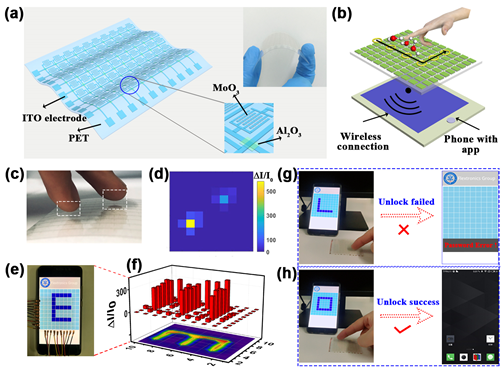Recently, a new progress in flexible humidity sensors and non-contact control systems has been achieved by the concerted efforts of Prof. SHEN Guozhen’s Group in Institute of Semiconductors, Chinese Academy of Sciences.
Human-machine interaction (HMI) technologies have attracted widespread attention due to their important applications in the internet of things (IoT), such as wearable electronics and telemedicine monitoring, etc.
For HMI systems, smart sensors play a key role since they can effectively “translate” various signals from the human body into information that the machine can recognize. Therefore, it is particularly important to develop diverse HMI sensors with high sensitivity and fast response. Traditional sensors generally detect signals in direct contacts, such as pressure sensors, strain sensors, etc. However, direct contact sensing not only brings inevitable mechanical wear but limits their use in a broader range of applications such as remote sensing and sensing in toxic or harmful environments.
In this case, a non-contact humidity sensor can be a noteworthy candidate to the existing sensors. Compared to the direct contact sensors, the humidity sensor can be controlled in a non-contact way through the humidity changes, which would be a novel control approach in advanced HMI interface.
In this work, Dr. SHI Ruilong and Assistant Prof. YANG Juehan in the team proposed a flexible and transparent high-performance humidity sensor based on MoO3 nanosheets synthesized by a low-cost and facile solution method. The as-prepared humidity sensor exhibits excellent sensitivity to external relative humidity (RH) with a current variation of five orders of magnitude by varying the RH from 0% to 100%. Moreover, the sensor has a rapid response (< 0.3 s) and recovery time (< 0.5 s) when RH increases from 0% to 40%, also demonstrates a long-term stability (> 1 month) and great flexibility toward mechanical deformation.
Furthermore, a wearable moisture analysis system is assembled for real-time monitoring of ambient humidity and human breathing states. Benefiting from the sensitive and rapid response to fingertips humidity, the sensors have been successfully applied to both a smart non-contact multistage switch and a novel flexible transparent non-contact screen for smart mobile devices, demonstrating the potential of the MoO3 nanosheets-based humidity sensors in future HMI systems.
This work entitled “Flexible smart non-contact control systems with ultrasensitive humidity sensors” was recently published in Small (DOI: 10.1002/smll.201902801). It was supported by the National Natural Science Foundation of China (61625404 and 61888102), and the Key Research Program of Frontier Sciences, CAS (QYZDY-SSW-JWC004).
The full-text link: https://onlinelibrary.wiley.com/doi/10.1002/smll.201902801

Flexible transparent noncontact control screen applications of the MoO3 nanosheets humidity sensor array.
